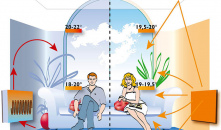Infrared heater or convector?

The choice of heating means largely depends on the person’s budget, his lifestyle and, of course, on the knowledge that he has in the field of heating. In the modern market there are several types of heating systems and they have fundamentally different characteristics. Infrared and convection systems are considered competitive - two modern, powerful and profitable technologies that have long vied for the right of superiority among customers. An infrared heater or convector is not an easy question, and in this article we will try to compare the two technologies as clearly and clearly as possible, describe their advantages and disadvantages.
Which heater is better - convector or infrared?
In order to compare these heating means, it is necessary to find out the essence and principle of operation of each of them. A convector heater, starting from the name itself, distributes heat through convection. Convection, in turn, is a type of heat transfer during which energy moves in streams. Heat transfer from convection systems is carried out by these very flows, which are evenly distributed. Their continuous action heats the air and gives a feeling of warmth and comfort.
The action of an infrared heater is similar to the action of sunlight. According to their principle, the heater does not heat the air itself, but objects that are in the room. In particular, it is wall furniture. Then these objects give off the accumulated heat, due to which a uniform, safe for health heating is carried out, and at the same time using a minimum amount of electricity. In this regard, infrared heaters really are in the lead - they can significantly reduce energy costs, which is especially true in the winter when there is a constant increase in heating prices.
Infrared heaters and convectors have different technological features. In convection systems, the main heat carrier is a convector radiator. In the on state, it is constantly heated and, interacting with the heat exchanger, spreads energy to the environment. To increase the heating area, often use special fins and tubes that supply the heater and direct the flow of warm air. The basis of the design of infrared heaters is an aluminum plate, which is heated by a tubular electric heater. The plate itself can reach a temperature of more than 200 degrees Celsius, however, at the same time, the case never heats more than 80 C, thanks to a well-thought-out heat dissipation system.
Which heaters are the most economical and efficient?
Understanding the principles of operation of heating equipment is what first of all helps you to choose the right heater based on your needs and preferences. Both systems are completely safe and protected from overheating. However, the principle of operation gives its differences: while convection heating works on the principle of streaming air heating, infrared radiation heats objects, thereby making the effect faster and longer. The room heated by the convector cools quickly enough - the convector switches on again and begins a powerful process of energy consumption. Of course, in this case, we can talk about temperature changes - from low to high, which can adversely affect health and well-being. Infrared heaters do not have this - they work on the principle of constant and uniform heating, do not mix cold and hot air flows, quickly heat the room and slowly cool. This is the explanation for their maximum profitability.
You can choose and get an infrared electric heater in our shop.
